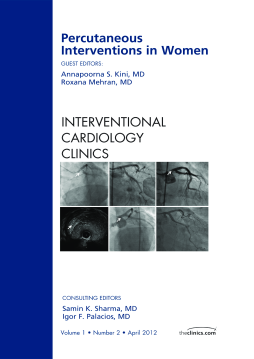
BOOK
Percutaneous Interventions in Women, An Issue of Interventional Cardiology Clinics - E-Book
Annapoorna S. Kini | Roxana Mehran
(2012)
Additional Information
Book Details
Abstract
Heart disease is the leading cause of death among US women over the age of 65, resulting in more deaths than all forms of cancer combined. Women are less likely to survive heart attacks than are men, possibly because symptoms in women may differ and may be less recognizable. In addition, women consistently tend to have worse clinical outcomes in percutaneous coronary interventions than do men. For these reasons, an issue on percutaneous interventions in women is timely.
Table of Contents
| Section Title | Page | Action | Price |
|---|---|---|---|
| Front Cover | Cover | ||
| Interventional Cardiology Clinics | i | ||
| Copyright Page | ii | ||
| Table of Contents | v | ||
| Contributors | iii | ||
| Preface: Coronary Artery Disease in Women: Shyly Bold? | ix | ||
| Chapter 1. An Approach to Asymptomatic and Atypically or Typically Symptomatic Women with Cardiac Disease | 157 | ||
| RISK DETECTION IN ASYMPTOMATIC WOMEN | 157 | ||
| EVALUATION OF SUSPECTED CARDIAC SYMPTOMS IN WOMEN | 158 | ||
| SUMMARY | 161 | ||
| REFERENCES | 161 | ||
| Chapter 2. Revascularization Strategies in Women with Stable Cardiovascular Disease: What do the Trials Reveal? | 165 | ||
| PATHOPHYSIOLOGY OF CAD IN WOMEN | 165 | ||
| REVASCULARIZATION STRATEGIES | 167 | ||
| CABG | 169 | ||
| SUMMARY | 170 | ||
| REFERENCES | 170 | ||
| Chapter 3. Interventional Management of ACS in Women: STEMI and NSTEMI | 173 | ||
| THE GENDER GAP | 173 | ||
| STEMI | 174 | ||
| NSTEMI | 174 | ||
| SUMMARY | 179 | ||
| REFERENCES | 179 | ||
| Chapter 4. The Generations of Drug-Eluting Stents and Outcomes in Women | 183 | ||
| DEVELOPMENT OF CORONARY STENTING | 183 | ||
| FIRST GENERATION OF DES | 183 | ||
| SECOND GENERATION OF DES | 188 | ||
| NEXT-GENERATION STENTS | 189 | ||
| SUMMARY | 191 | ||
| REFERENCES | 191 | ||
| Chapter 5. PCI Outcomes in High-Risk Groups (Diabetes Mellitus, Smoker, Chronic Kidney Disease and the Elderly) | 197 | ||
| WHAT IS HIGH-RISK PCI? | 198 | ||
| SUMMARY | 202 | ||
| REFERENCES | 202 | ||
| Chapter 6. Vascular Complications in Women and the Radial Approach | 207 | ||
| GENDER DIFFERENCES | 207 | ||
| CLINICAL AND PROCEDURAL PREDICTORS | 208 | ||
| USE OF ANTITHROMBOTIC AGENTS IN WOMEN | 208 | ||
| RADIAL APPROACH | 208 | ||
| SUMMARY | 210 | ||
| REFERENCES | 210 | ||
| Chapter 7. Is Stenting an Appropriate Therapy in Women Presenting with Acute Coronary Syndrome? A Pathologist’s Perspective | 213 | ||
| HISTOPATHOLOGY OF ACS AND THROMBOSIS | 214 | ||
| HISTOPATHOLOGY OF STENTED CORONARY ARTERY | 216 | ||
| REFERENCES | 220 | ||
| Chapter 8. Does Gender have an Influence on Platelet Function and the Efficacy of Oral Antiplatelet Therapy? | 223 | ||
| GENDER-RELATED DIFFERENCE IN PLATELET REACTIVITY | 225 | ||
| GENDER-RELATED DIFFERENCE IN PLATELET REACTIVITY | 226 | ||
| ANTIPLATELET RESPONSE TO ASPIRIN IN WOMEN | 227 | ||
| ANTIPLATELET RESPONSE TO ASPIRIN AND CLOPIDOGREL IN WOMEN | 227 | ||
| SUMMARY | 228 | ||
| REFERENCES | 228 | ||
| Chapter 9. Cardiogenic Shock in Women | 231 | ||
| THE SCOPE OF THE PROBLEM | 231 | ||
| CAUSES OF CARDIOGENIC SHOCK | 232 | ||
| RISK FACTORS FOR DEVELOPMENT OF CARDIOGENIC SHOCK | 232 | ||
| PATHOPHYSIOLOGY | 232 | ||
| CARDIOGENIC SHOCK IN SPECIAL SITUATIONS | 234 | ||
| THERAPEUTIC OPTIONS | 235 | ||
| SUMMARY | 239 | ||
| REFERENCES | 239 | ||
| Chapter 10. Percutaneous Valve Therapy: Choosing the Appropriate Patients and Outcomes | 245 | ||
| GENDER DIFFERENCES IN TREATMENT AND OUTCOME IN SEVERE AS | 246 | ||
| GENDER DIFFERENCES IN PERCUTANEOUS AORTIC VALVE IMPLANTATION | 246 | ||
| GENDER DIFFERENCES IN THE ITALIAN PERCUTANEOUS AORTIC VALVE REGISTRY | 248 | ||
| SUMMARY | 248 | ||
| REFERENCES | 249 | ||
| Chapter 11. Future Perspectives on Percutaneous Coronary Interventions in Women | 251 | ||
| EPIDEMIOLOGY OF CVD | 251 | ||
| REVASCULARIZATION STRATEGIES | 252 | ||
| CORONARY STENTING IN WOMEN | 253 | ||
| BLEEDING AND VASCULAR COMPLICATIONS | 253 | ||
| CLINICAL RISK SCORES AND WOMEN | 254 | ||
| BARRIERS | 254 | ||
| SUMMARY | 255 | ||
| REFERENCES | 256 | ||
| Index | 259 |
